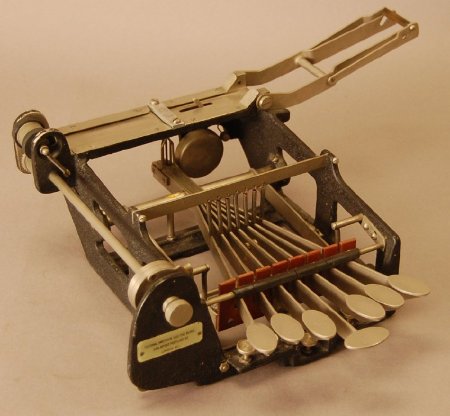Object ID:
2009.28
Title:
Stainsby "E" Braille Shorthand Writer
Creator:
Royal National Institute for the Blind
Description:
Open, cast brass frame, black textured enamel; seven bright nickel oval keys, space key extends toward user a bit in middle and key is turned perpendicular to the other keys; key bars are nickel steel, suspended from crossbar by springs, pads mounted below each key, rubber padded bar above, key bars also rest in cutouts in brown composite shield; knurled thumbkey at left mounted in frame to advance paper roll mounted in nickel steel frame on back of frame, ratchet action, secondary spring-loaded advance roller on back, features two rubber bands; paper roll apparatus folds inward to left for compact storage; plate mounted on left front of frame, "NATIONAL INSTITUTE FOR THE BLIND/228 GREAT PORTLAND ST./LONDON W.I."; stamped on top of diebox, "E 137".
Dimensions:
H-5 W-13 D-11 inches
Date:
ca. 1940
Made by:
National Institute for the Blind
Place of Origin:
London, England
Provenance:
Owned by former APH research head and Hall-of-Famer Samuel Ashcroft (1921-2006).
Henry Stainsby (1859-1925), Supt. of the Birmingham Royal Institution for the Blind, along with Birmingham manufacturer Albert Wayne patented a braille shorthand machine in 1899-1900. His tapewriter was developed as a note-taking tool to facilitate the training of blind stenographers at Birmingham. Stainsby's goal was employment for his students. The Model E appeared in the Institute's 1940 catalog but was available as early as 1936. It was replaced by the more dramatically revised Model F in 1948.
Henry Stainsby (1859-1925), Supt. of the Birmingham Royal Institution for the Blind, along with Birmingham manufacturer Albert Wayne patented a braille shorthand machine in 1899-1900. His tapewriter was developed as a note-taking tool to facilitate the training of blind stenographers at Birmingham. Stainsby's goal was employment for his students. The Model E appeared in the Institute's 1940 catalog but was available as early as 1936. It was replaced by the more dramatically revised Model F in 1948.
Credit Line:
Gift of Wendy Ashcroft, 2009.28
